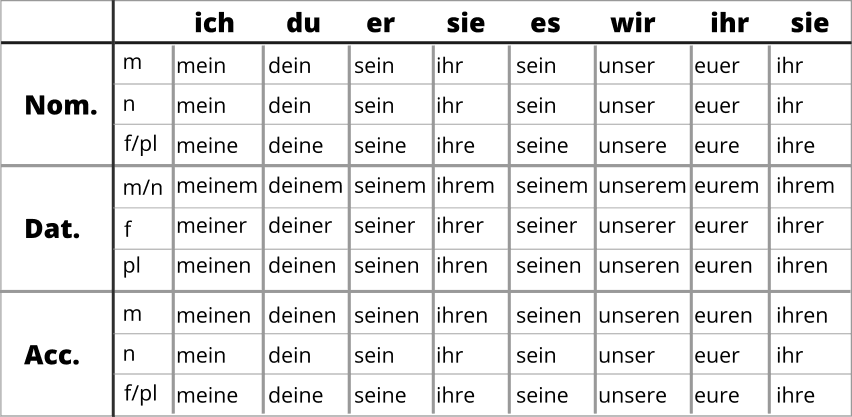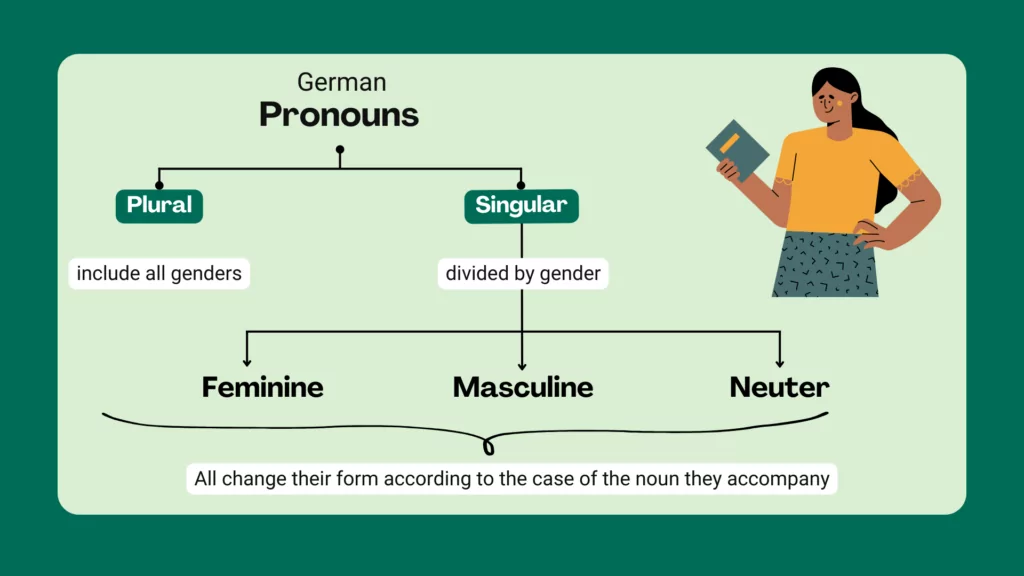German possessive pronouns play a crucial role in expressing ownership and indicating relationships in the German language. Understanding how to use them correctly is essential for effective communication. In this comprehensive guide, we will delve into the rules, examples, and exercises that will help you master German possessive pronouns. Whether you’re a beginner or looking to refine your skills, this article will provide valuable insights and practical tips for using possessives in German.

✅ AI Essay Writer ✅ AI Detector ✅ Plagchecker ✅ Paraphraser
✅ Summarizer ✅ Citation Generator
Understanding German Possessive Pronouns

German possessive pronouns, known as “possessivpronomen” in German, are words that replace nouns to show ownership or possession. These pronouns agree with the gender, number, and case of the noun they replace. Let’s explore the various aspects of German possessive pronouns in detail.
Forms of German Possessive Pronouns
German possessive pronouns have different forms depending on the grammatical context. Here are the forms of possessive pronouns in German:
- Singular:
- Masculine: mein (my), dein (your), sein (his), ihr (her), Ihr (your – formal)
- Feminine: meine, deine, seine, ihre, Ihre
- Neuter: mein, dein, sein, ihr, Ihr
- Plural:
- All genders: unser (our), euer (your – plural), ihr (their), Ihre (your – formal)
Declension of German Possessive Pronouns
German possessive pronouns change their form according to the case of the noun they accompany. The following table illustrates the declension of possessive pronouns in German:

Usage of German Possessive Pronouns
German possessive pronouns are used to indicate ownership or possession. They are placed before the noun they modify and must agree with the gender, number, and case of the noun. Here are some examples to illustrate their usage:
- Das ist mein Hund. (This is my dog.)
- Wo ist deine Tasche? (Where is your bag?)
- Sein Auto ist blau. (His car is blue.)
- Ihr Buch liegt auf dem Tisch. (Her book is on the table.)
- Unser Haus hat einen großen Garten. (Our house has a large garden.)
- Sie spielen mit ihren Kindern. (They are playing with their children.)
Common Mistakes with German Possessive Pronouns
While learning German possessive pronouns, it’s important to be aware of common mistakes. Here are a few pitfalls to avoid:
- Confusing possessive pronouns with possessive adjectives:
- Possessive pronouns: Das ist mein Buch. (This is my book.)
- Possessive adjectives: Das ist meine Buch. (This is my book.)
- Forgetting to decline possessive pronouns based on gender, number, and case:
- Correct: Er hat seinen Hut verloren. (He lost his hat.)
- Incorrect: Er hat sein Hut verloren.
- Incorrect gender agreement:
- Correct: Ihr Vater ist Arzt. (Her father is a doctor.)
- Incorrect: Ihre Vater ist Arzt.
Conclusion

Congratulations! You’ve gained a solid understanding of German possessive pronouns. By mastering the forms, declension, and usage of these pronouns, you’ll enhance your ability to express ownership and relationships in the German language. Remember to practice regularly and pay attention to gender, number, and case agreements. With dedication and persistence, you’ll become proficient in using German possessive pronouns with ease. Keep exploring the fascinating world of German grammar and enjoy your language learning journey!
FAQs
How do possessive pronouns differ from possessive adjectives in German?
Possessive pronouns and possessive adjectives in German both indicate ownership or possession, but they differ in their grammatical function. Possessive adjectives modify nouns directly, while possessive pronouns replace nouns. Possessive adjectives agree with the gender, number, and case of the noun they modify, whereas possessive pronouns agree with the gender, number, and case of the noun they replace.
For example:
- Possessive adjective: Das ist mein Buch. (This is my book.)
- Possessive pronoun: Das ist meins. (This is mine.)
2. Can German possessive pronouns change based on gender?
Yes, German possessive pronouns change based on the gender of the noun they replace. They have different forms for masculine, feminine, and neuter nouns.
For example:
- Masculine: Sein Hund (his dog), Ihr Hund (her dog)
- Feminine: Ihre Katze (her cat), Unsere Katze (our cat)
- Neuter: Sein Buch (his book), Ihr Buch (her book)
3. What are the different forms of possessive pronouns in German?
German possessive pronouns have different forms for different genders, numbers, and cases.
- Masculine: mein, dein, sein, ihr, Ihr
- Feminine: meine, deine, seine, ihre, Ihre
- Neuter: mein, dein, sein, ihr, Ihr
- Plural: unser, euer, ihr, Ihre
4. Can possessive pronouns be used with nouns in the genitive case?
Yes, possessive pronouns can be used with nouns in the genitive case in German.When a noun in the genitive case is replaced by a possessive pronoun, the pronoun agrees with the gender, number, and case of the noun it replaces.
For example:
- Der Schlüssel des Mannes (the man’s key)
- Der Schlüssel seines (his key)
Follow us on Reddit for more insights and updates.
Comments (1)
Welcome to A*Help comments!
We’re all about debate and discussion at A*Help.
We value the diverse opinions of users, so you may find points of view that you don’t agree with. And that’s cool. However, there are certain things we’re not OK with: attempts to manipulate our data in any way, for example, or the posting of discriminative, offensive, hateful, or disparaging material.





Thank you for the article. I found the table very helpful. I’ve been living in Austria for over 5 years and still struggling with this crazy gender-obsessed sprache. I’ve been working full-time in English-speaking jobs with little time to spend on this nonsense, but have to learn it for the permanent permit anyway.
Forgive my rant. Here is my question. How do you know the sentence “Ihr Vater ist Arzt.” translates to “Her father is a doctor.”? According to the table, it could be “Their father is a doctor.”. Am I missing something or it’s the text context that normally would help interpret it correctly?